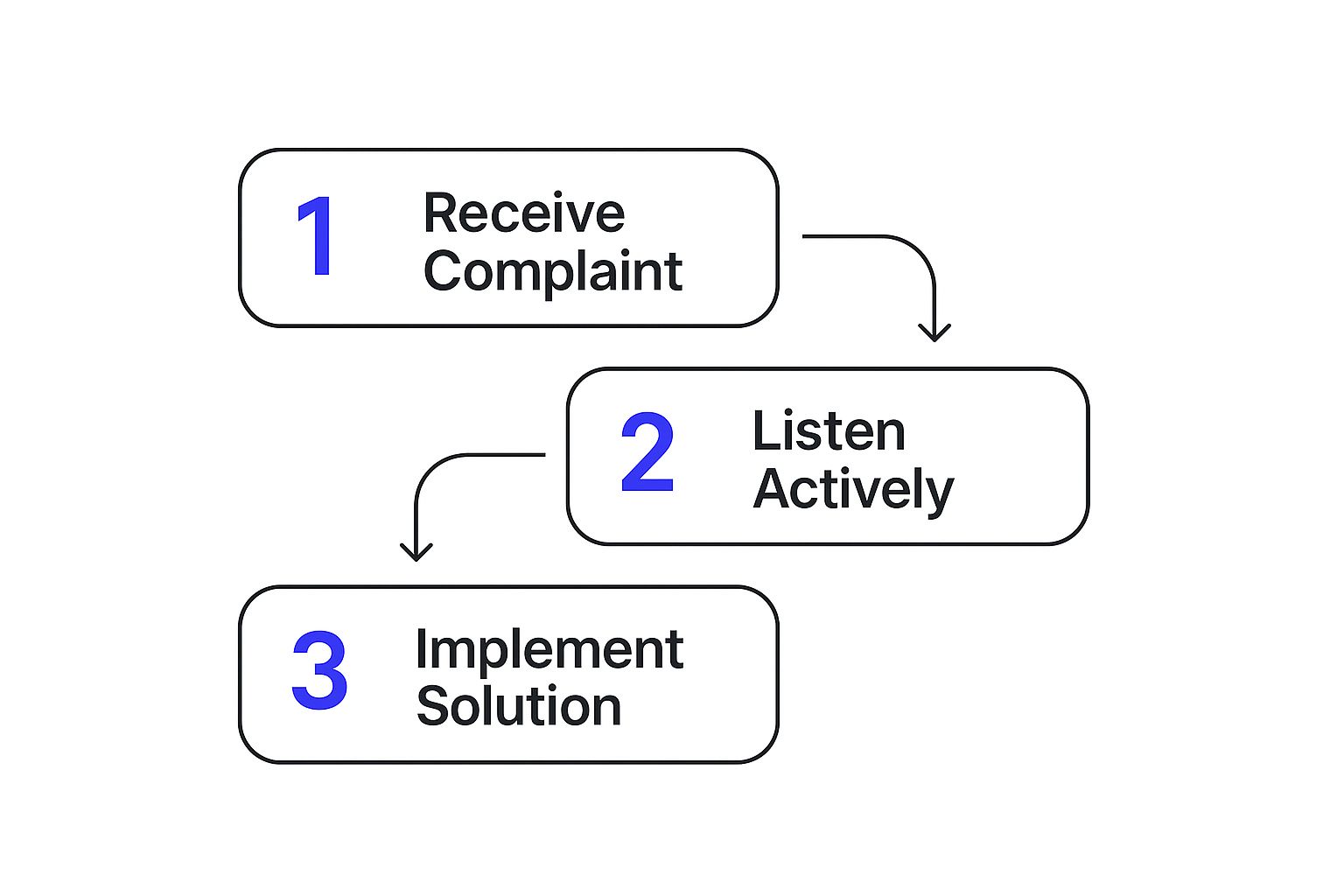When a customer complaint comes in, it's easy to see it as a headache. But I've learned over the years that the best way to handle these situations is to stick to a simple but incredibly effective framework: Listen, Empathize, Solve, and Follow-Up. This approach gives you a clear roadmap, turning what feels like a crisis into a genuine opportunity to build a stronger customer relationship.
Why Every Complaint Is a Hidden Opportunity
Let's get one thing straight: a customer complaint isn't just a problem. It's a critical moment of truth for your business. Too many service companies treat complaints as an annoyance, but they're really a gift—direct, unfiltered feedback from the very people keeping you in business.
Think about it. Most unhappy customers don't actually take the time to complain. They just quietly find another company for their next project and you never hear from them again. When someone reaches out with a problem, it means they still have some faith that you can make it right. That's a golden opportunity you can't afford to waste.
The Foundation of Complaint Resolution
The goal here isn't just damage control; it's about building a real, lasting relationship. I’ve seen it happen time and time again: a well-handled complaint can turn a seriously unhappy customer into your most vocal supporter. The secret is having a solid process that everyone on your team—from the office staff to the techs in the field—knows and can follow every single time.
This process kicks in the second a complaint lands on your desk and walks you through everything from truly hearing the customer out to implementing a fair fix. The flowchart below maps out this straightforward workflow.

As you can see, the path from problem to resolution is pretty clear once you make listening your top priority.
Getting this right has a massive impact. Research shows that when you resolve a complaint in the customer's favor, an incredible 70% of them will do business with you again. The problem is, there's a huge gap between theory and practice. A staggering 84% of customers feel their expectations weren't met during their last service interaction. You can dig deeper into these kinds of customer service statistics to see just how much room for improvement there is.
A complaint is the beginning of a conversation that can lead to a better business. It’s a roadmap for improvement handed to you directly by your customers.
To help you build a system that works, let's look at the four phases that form the backbone of any good complaint resolution process. Each stage has a specific purpose, giving your team a reliable framework to lean on.
The Four Phases of Effective Complaint Resolution
This table breaks down the core stages for handling any customer complaint, from that first frustrated phone call to the final follow-up.
| Phase | Key Action | Goal |
|---|---|---|
| Listen | Let the customer share their full story without interruption. | Understand the core issue and make the customer feel heard. |
| Empathize | Acknowledge their frustration and validate their feelings. | Build rapport and de-escalate emotional tension. |
| Solve | Propose a fair, effective solution to the problem. | Restore the customer’s confidence and fix the issue. |
| Follow-Up | Check in after resolution to ensure they are satisfied. | Solidify goodwill and confirm the solution worked. |
By embedding these four phases into your company culture, you can consistently turn negative feedback into your most powerful tool for growth and customer loyalty.
Creating a System to Catch Every Complaint
If a customer complains and no one is there to hear it, did it even happen? For your business's reputation and bottom line, it absolutely did. An unresolved complaint is more than a single lost customer; it’s a potential bad review, negative word-of-mouth, and a missed opportunity to get better.
You simply can't solve a problem you don't know exists. That's why the very first step is to build a reliable system for catching every single piece of feedback—good, bad, or ugly. Forgetting this is like trying to fix a leaky pipe with your eyes closed. You might get lucky, but you'll probably end up with a much bigger mess.
Building Your Logging System
When you're just starting out, your system doesn't need to be fancy. Honestly, a well-organized spreadsheet can be a lifesaver. This isn't just a list; it’s a living document that tracks the who, what, when, and how of every complaint.
The real key is consistency. When things get busy (and they always do), you need a process that captures the right details every time. Make sure every entry includes:
- Customer Info: Name, phone number, and service address.
- The Complaint: A clear, concise summary of the issue and the date it was reported.
- Who's on It: The team member assigned to make things right.
- Current Status: Is it new, in progress, or resolved?
- The Resolution: What was the final outcome? What did we do to fix it?
This simple, structured approach takes you from reactive firefighting to organized problem-solving. Of course, you shouldn't just wait for complaints to roll in. It's just as important to learn how to get customer feedback proactively to catch potential issues before they escalate.
As your business grows, you'll feel the limits of that spreadsheet. That's when you know it's time for a proper Customer Relationship Management (CRM) tool.
I remember when my own company finally upgraded from spreadsheets to a basic CRM. It was an absolute game-changer. Suddenly, we could see every single interaction a customer had with us—every call, every job, every past issue—all in one place. It immediately stopped us from making a frustrated customer repeat their story for the third time.
CRMs centralize all your customer data, giving anyone on your team the full context they need in seconds. The dashboard below gives you an idea of how a CRM can organize customer interactions visually.

This kind of big-picture view helps you spot patterns and manage customer relationships far more effectively than any spreadsheet ever could.
Prioritizing and Categorizing Issues
Once you have a steady stream of feedback coming in, the next step is to make sense of it all. This is where categorizing comes in. Are you getting a lot of complaints about scheduling mix-ups? Or maybe one particular service seems to be causing headaches?
By tagging each complaint (e.g., "scheduling," "work quality," "billing"), you start turning individual problems into actionable data. It's how you spot a trend before it becomes a crisis.
This isn't just a small-business problem; it's a massive focus for companies of all sizes. The complaint management software market was valued at $1.93 billion back in 2018 and is projected to skyrocket to $8.29 billion by 2026. That tells you just how seriously businesses are taking customer feedback.
Your system should also help you prioritize. Let's be real: not all complaints carry the same weight. A minor scheduling error for a routine maintenance visit is important, but a major service failure that could result in property damage or a scathing online review needs your immediate, full attention.
Create a simple triage system—something like Low, Medium, and High priority—to ensure your team is always tackling the most urgent fires first.
Investigating the Issue and Acknowledging It Quickly

The moment a complaint lands in your inbox or your phone rings, the clock is running. How you react in these first few minutes and hours will define the entire experience for that customer. Your first moves—a swift investigation and an immediate acknowledgment—are critical. This isn't just about damage control; it's your first, best chance to show the customer you're on their side.
Before you can solve anything, you need to understand exactly what went wrong. The key here is to gather the facts without playing the blame game. Your goal is to build a complete picture of the situation, not to point fingers.
Start by digging into your own records. Pull up the job file, review the service notes, and look at any before-and-after photos your crew took. What was the original job scope? Did the notes mention anything unusual or any specific requests from the homeowner?
Next, it’s time to talk to your people on the ground. When you approach your technician or team, keep your tone collaborative, not accusatory. You’re on a fact-finding mission together.
Try asking open-ended questions to get their unfiltered perspective:
- "Hey, can you walk me through what happened on the Smith job last week?"
- "Did anything come up on-site that was different from what we expected?"
- "How was the customer's mood when you left? Did they mention any concerns?"
This internal debrief is non-negotiable. Your team was there, and their insights are often the missing piece of the puzzle.
Acknowledge the Complaint—Immediately
While you're piecing things together internally, your customer is stewing. Silence is your enemy. It makes them feel dismissed and escalates their frustration. That’s why you have to send a quick acknowledgment, even if you don't have all the answers yet.
Speed is everything. We’ve all been there—firing off a complaint and then hearing nothing but crickets. Research actually shows that customers who get a response in under five minutes are often willing to spend more with that company in the future. A fast reply shows respect.
Your initial message is all about managing expectations and reassuring the customer that you're on it. This simple act can transform a moment of high tension into a sigh of relief.
“Hi [Customer Name], thanks so much for reaching out and bringing this to my attention. I'm really sorry to hear you're running into an issue with our recent work—that’s not the experience we ever want for our customers. I'm personally looking into what happened right now and will circle back with you before the end of the day. I appreciate your patience as I get this sorted out.”
A message like this works wonders because it:
- Validates their feelings: It tells them, "I hear you, and you're right to be upset."
- Sets a clear timeline: They aren't left wondering when they'll hear from you again.
- Shows you're taking ownership: You’re already working on it.
By acknowledging the problem right away and starting a fair investigation, you lay a foundation of trust. It makes the customer feel heard and respected, which makes finding a resolution that much easier down the line.
Crafting a Fair and Effective Resolution

Okay, you've listened to the customer and dug into what went wrong. Now comes the moment that really defines your company’s reputation: solving the problem. This is where you pivot from words to action. A solid resolution doesn't just fix a mistake; it can turn a frustrated customer into a loyal advocate.
Many experienced pros lean on a simple but powerful framework: Listen, Apologize, Solve, and Thank (L.A.S.T.). You've already done the listening and apologized. Now, the "Solve" part is your chance to rebuild trust and show you mean business.
Choosing the Right Solution
There’s no one-size-fits-all fix for customer complaints. The solution has to fit the crime, so to speak. A small paint scuff on a wall doesn't warrant the same response as a leaky pipe your crew just installed. You need to tailor your approach.
Here are a few tools in your resolution toolbox, from minor gestures to major make-goods:
- Re-doing the work: For any quality-related issue, this is usually the first and best option. It proves you stand behind your work, period.
- Offering a partial refund: If the mistake is minor and can't be perfectly redone, a partial refund shows you acknowledge the hassle.
- Providing a future service credit: This is a fantastic way to keep the customer in your orbit and give them a reason to try your services again.
- A small gift or gesture: For smaller slip-ups, a simple gift card for coffee or a local restaurant can go a long way.
Let's say your landscaping crew accidentally ran over a client's prized rose bush. A simple "sorry" won't cut it. A much better response would be to immediately source and plant a replacement bush, and then offer a credit for their next lawn service. That approach addresses the specific damage and adds a gesture of goodwill.
When things get really heated, knowing how to deal with irate customers is crucial for lowering the temperature and getting to a solution.
Remember the goal: It's not just about fixing the immediate issue. It’s about restoring the customer’s faith in your company. A fair resolution sends a clear message: even when things go wrong, you’ll make it right.
Empowering Your Team to Act Fast
One of the biggest roadblocks to a quick resolution is a team that isn't empowered to make decisions. Nothing frustrates a customer more than hearing, "I need to get my manager to approve this." That delay feels like a brush-off.
Give your frontline team the authority to resolve issues on the spot. Set clear guidelines for what they can offer without needing a green light. For example, maybe any technician or office staff member can offer up to a $50 service credit or schedule a no-cost follow-up visit on their own.
This autonomy is a game-changer. It's no surprise that businesses resolving issues during the first contact can prevent up to 67% of customer churn. When your team can solve problems quickly, customers feel heard and respected. It’s the fastest way to turn a complaint into a win.
Turning Feedback into Business Improvements
Fixing one customer's problem is a good start, but that's not where the real work ends. If you want to build a truly resilient business, you have to use that feedback to make systemic improvements. This is where we separate the amateurs from the pros.
It’s about moving from a reactive, fire-fighting mode to a proactive one where you’re building a fire-resistant company. Every complaint, when handled right, is a roadmap showing you exactly where you need to get better.
Solidifying Goodwill with a Follow-Up
Once you’ve resolved an issue, the job isn’t quite done. A quick follow-up a few days later—whether it's a simple phone call or a personal email—can turn a good resolution into a fantastic one. It’s a small step that shows you're not just about closing a ticket; you genuinely care about their satisfaction.
Keep it simple and personal. Something like this works wonders:
“Hi [Customer Name], just wanted to personally check in and see how everything is holding up after our visit last week. Your satisfaction is our top priority, and we really appreciate you giving us the chance to make it right.”
This little gesture does more than you'd think. It locks in that positive resolution in the customer's mind, reinforcing that you stand by your work long after your truck has pulled away. For the effort involved, the impact on building lasting loyalty is huge.
Analyzing Trends to Find the Root Cause
Now for the game-changer: turning that raw feedback into intelligence you can actually use. That log you're keeping—whether it's a simple spreadsheet or a fancy CRM—is a goldmine. You need to block out time regularly to dig into it and hunt for patterns.
Are you noticing the same problems popping up over and over again? Look for trends tied to specific services, teams, or even your internal processes.
- Service-Specific Problems: Are you getting a lot of calls about "messy job sites" after your drywall repair jobs? Maybe it's time to double-down on your team's cleanup protocol for that specific service.
- Team Training Gaps: Is one particular technician's name attached to most of your scheduling mix-ups or callbacks? That’s not a signal to point fingers, but a clear sign that some targeted training is needed.
- Flawed Processes: Do customers frequently complain about unexpected charges on their final invoice? That tells you your quoting process isn't clear enough and needs a serious re-evaluation.
When you start categorizing and analyzing feedback this way, you stop just treating the symptoms and start curing the underlying disease. To make sure these insights lead to real, lasting change, you need to build a formal customer service improvement plan. This gives you a structured way to turn observations into action.
This is how you get ahead of customer complaints for good. You make small, smart adjustments to your operations that prevent the same issues from ever happening again, building a much stronger home service business in the process.
Your Top Complaint Handling Questions, Answered
Even with the best system in place, some complaints are just plain tricky. You’ll inevitably run into situations that don't fit neatly into a process. Let's walk through some of the most common and nuanced questions I hear from home service business owners out in the field.
What Should I Do If a Customer Complaint Is Unreasonable or False?
This is a tough one, and it happens to everyone. The customer is insisting your tech tracked mud all over their brand-new white carpet, but your tech’s photos show they wore shoe covers from the moment they stepped inside.
Your first move is always to start with empathy, even when you’re pretty sure the claim is bogus. A simple, "I can see why this would be upsetting," or "I understand how frustrating this is for you," goes a long way. It shows you're listening and you care, which can lower the temperature immediately without you having to admit fault.
Next, it's time to do your homework. Quietly and professionally, gather your evidence. This could be before-and-after photos from the job, GPS logs, or detailed notes from your technician's report. Once you have the facts, you can present them calmly and politely.
Sometimes, even when you're 100% in the right, a small gesture of goodwill can save the customer relationship. Offering a 10% discount on their next cleaning or tune-up might feel like a loss, but it costs very little and shows you value their business, smoothing over the disagreement.
But you also need to know when to stand firm. If a customer is making irrational demands, becomes abusive, or is clearly trying to get a free service they don't deserve, it's okay to state your final position politely and end the conversation. Protecting your team from abuse is just as important as customer service.
How Can I Train My Team to Handle Complaints Effectively?
Great complaint handling isn't something people are born with; it's a skill you have to build. Tossing a manual at your CSRs and hoping for the best just won't cut it. Your training needs to be practical, hands-on, and continuous.
- Role-Play Real Scenarios: Get your team together and act out common complaint situations. What do you say when a customer is furious about a bill? How do you handle a scheduling mix-up? Practicing these conversations builds the muscle memory they need to stay calm and professional when a real customer is yelling on the phone.
- Create Simple Frameworks (Not Rigid Scripts): Give your team some go-to opening lines and phrases that steer conversations toward listening and de-escalation. The goal isn't to have them sound like robots, but to give them a solid, reliable starting point when they're under pressure.
- Empower Them to Solve Problems: This is the single most important step. Give your front-line staff the authority to offer pre-approved solutions on the spot. Maybe it's a $25 service credit or the power to waive a dispatch fee. When they can resolve an issue in one call without saying, "I have to ask my manager," you look incredibly efficient and the customer feels truly heard.
Finally, make learning a team sport. Once a month, review a few anonymized complaints in your team meeting. Talk about what went well, what could have been better, and brainstorm solutions together. This turns complaint handling from a dreaded task into a shared challenge for improvement.
When Is a Phone Call Better Than an Email?
Knowing which tool to use for the job is critical. The channel you choose should match the urgency and emotional weight of the complaint.
Email is perfect for:
- Sending that first, quick acknowledgment that you've received their message.
- Sharing documents, photos, or detailed quotes.
- Creating a written record of your conversation and the agreed-upon solution.
A phone call becomes non-negotiable when:
- The problem is serious or has multiple moving parts that are hard to explain in writing.
- The customer is clearly very emotional, angry, or distressed.
There’s a power in the human voice that email and text just can't match. Hearing a calm, empathetic tone can instantly de-escalate a tense situation. My rule of thumb is this: if the customer is upset or the issue is complex, pick up the phone. You can always send a follow-up email summarizing what you both agreed to.
Feeling like customer communications is a full-time job in itself? Phone Staffer can take that weight off your shoulders. We provide professionally trained, remote CSRs and VAs to answer your phones, nurture leads, and handle your admin work, freeing you up to focus on what you do best. Learn more about how we can support your team.

